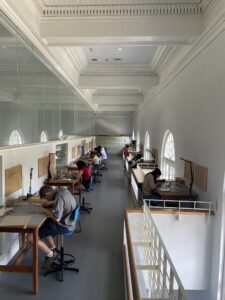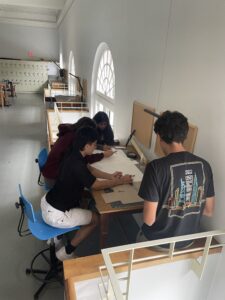Brian takes his teaching work as an opportunity to reorient architecture toward the humanities.
Reflections on teaching
August 15, 2023
Architects that teach: it’s a thing. Throughout the history of the profession, architects have learned their trade in some variation of an apprenticeship model – weathered practitioners mentoring young apprentices to become the next generation of professionals.
Because of the deep relationship between academic and practical education, there are many architects today who balance time between professional practice and teaching in academic institutions. Placework co-founder and Principal Brian Murphy is one of them. ”In a sense, we are all learning and teaching at the same time, all the time throughout our careers,” Brian believes. “So, whether that’s happening in the office or in the school, it’s a great thing either way.”
Brian teaches Intro to Architectural Design at the University of New Hampshire and an architectural studies course in the summer enrichment program at Phillips Exeter Academy. He sees this as a unique opportunity and a privilege. “Typically, architects want to teach in the high-profile architecture schools. They want to work with students who are advanced in their studies and committed to pursuing the profession,” he says. “I love working with ‘first-timers’ – the young learners who may be interested but don’t know much about architecture. What an opportunity to create a new paradigm for how humans perceive their relationship with their environment, built and natural!”
If a student goes on to pursue a degree in architecture, and a career beyond that, Brian thinks that’s a bonus. If a student goes into public policy and understands how buildings and infrastructure affect our health and wellbeing, our economy, the natural world, and how policy affects the way we build, that might be even better. Understanding interrelationships is important and we all need to approach our work with systems thinking. Everything is connected.
His highest hope is that no matter where students go after his courses, they will become part of a society with a broader awareness of the higher potential of buildings and the built environment.
“That’s what I think is really at stake here; we can bring about a culturally engrained sensibility that everything we build is a positive act of caring for each other and the environment.”
Stretching architecture education beyond the accredited degree programs is an opportunity to bring more people closer to the process of shaping the built environment. Making architecture more accessible and relatable to more people – not just teaching about form and style but understanding its true effects on our lives – would be one ideal outcome of education in architecture.

Making architecture education available and welcoming to more people is another good goal. Capturing the interest of people with different experiences and perspectives could mean more professionals working in the built environment fields who better represent our communities. This would enable more inclusive design thinking and decision making about how we shape our towns and cities.
Many students are interested in architecture, as an elective or as a major. Some of them immediately count themselves out because they perceive it as math and science intensive. Indeed, many students come to architecture because of its technical or technological aspects. Brian takes his teaching work as an opportunity to reorient architecture toward the humanities. He believes we have been shouting STEM for too long without insisting on being grounded in the human experience. “I want students to start there, explore what an architecture that responds to that can be, and then go find the technologies to support it.”

Working with students outside of conventional architecture school is something Brian finds intriguing. “They have a different attitude and approach,” he says. “Architecture is not everything to them. It’s a curiosity. I have to convince them, in a way. I have to respect them and care for them or I can easily lose them. That was not my experience in architecture school. I felt like I had to keep up and learn to think like my teachers or I wouldn’t be part of the club.” This is not uncommon, and it has to change, or we will suffocate the profession.
Many architects today are working purposefully to recreate our professional image, both in practice and in academia, to communicate our commitment to community and planet. Our work affects everyone, and we take that seriously. It’s more than establishing a new relevance, it’s offering a new usefulness.
When asked how he feels about his (relatively short) teaching career so far, Brian reflects on the privilege he feels: “Students where I teach invest so much of themselves just to show up and give an architecture courses a try, I’m so grateful just to be in the room with them. It’s inspiring. If they only knew how much I’m learning from them.”